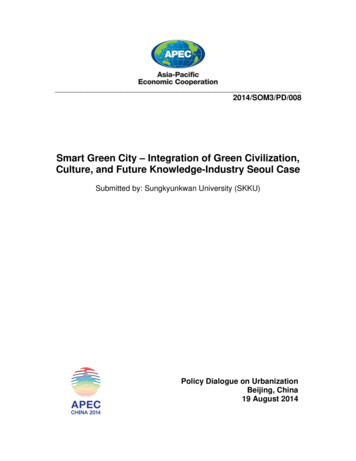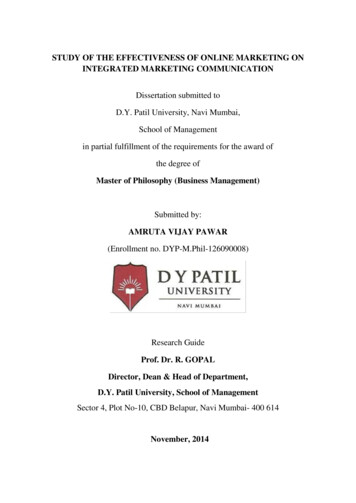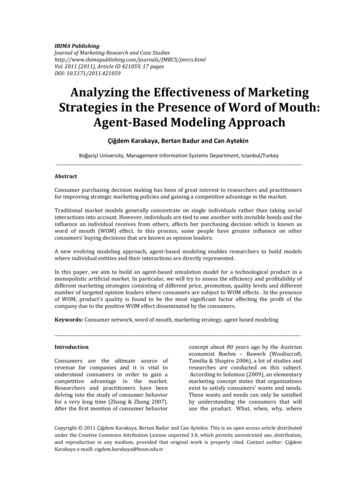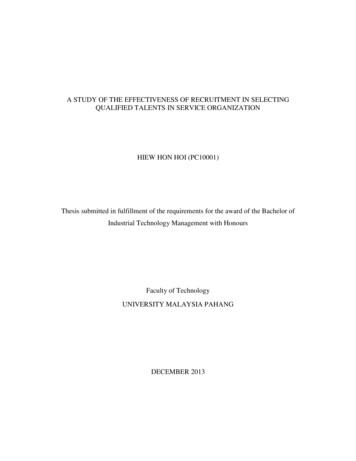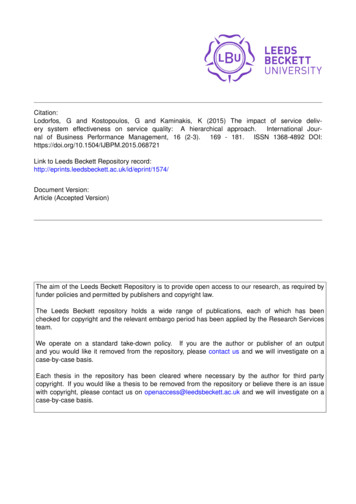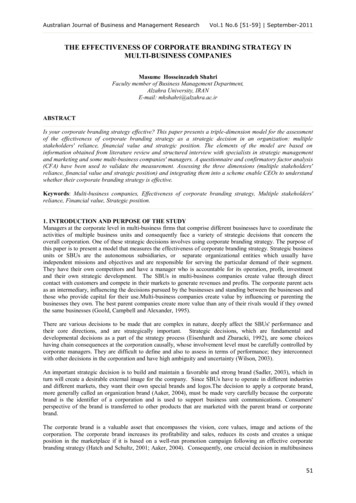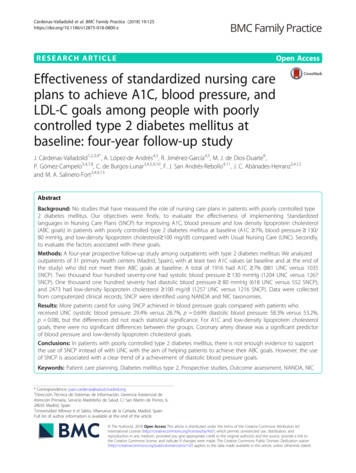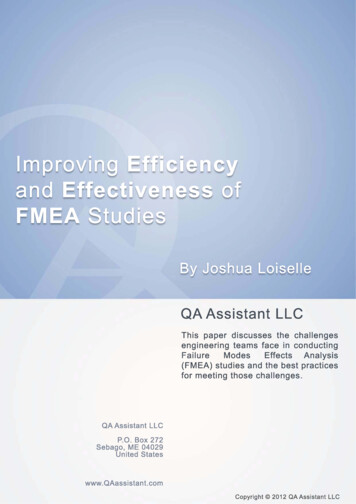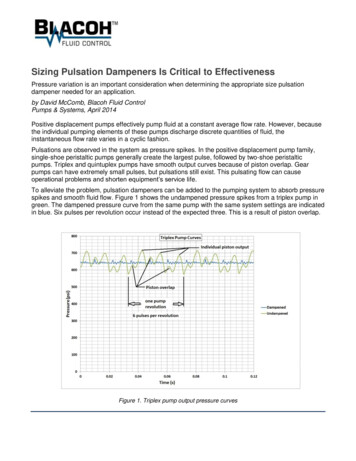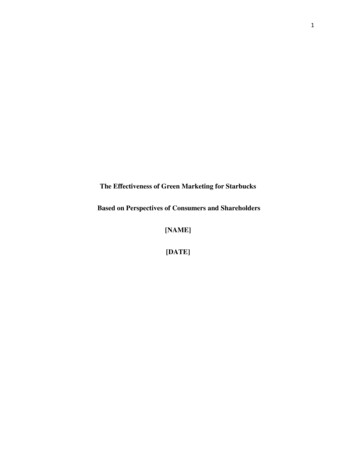
Transcription
1The Effectiveness of Green Marketing for StarbucksBased on Perspectives of Consumers and Shareholders[NAME][DATE]
2Table of ContentsAbstract .4I.Introduction1.1Background to the research . .51.2Relevance of the study . .61.3Research purpose and objectives .61.4Structure of the rest of the report .8II. Literature Review2.1. Corporate Social Responsibility .92.2. Green Marketing .132.3. Consumers’ Current Behavior and Attitudestowards Environmental Issues .142.4. Principles of Green Marketing 152.5. Reasons for Adopting Green Marketing .172.6. Strategies for Green Marketing .182.6.1. Use of Incentive as motivation 192.6.2. Disclosure of Information .192.7. Starbucks Company Profile .232.8. Starbucks Green Marketing Program .28III. Methodology3.1. General Research Problem and Style Chosen .353.2. Hypothesis .363.3. Research Questions .373.4. Methods of Analysis .373.5. Data Sources .40IV. Discussion4.1. Interpretation of Results 42
3V. Conclusion5.1. Evaluation of Hypothesis .505.2. Limitation of Current Research 525.3. Recommendations .53Bibliography .55Appendix A Interview Questionnaire .57Appendix B Survey Questionnaire .60Appendix C Interview Chart Results 62Appendix D Survey Chart Results 72
4AbstractGreen marketing strategies is a relatively new marketing approach wherein the emphasisis made on using sustainable practices and delivering a final product that meets environmentalstandards. It has also become synonymous with Corporate Social Responsibility as morecompanies are engaged in uplifting the lives of the community they operate in. This dissertationevaluates green marketing strategies applied by Starbucks and examines its efficiency inimproving the company’s brand equity and performance. It analyses the company’s businessviability and longevity and determines the impact made with the application of green marketingtactics. This action research study analyses consumer and stakeholder perspectives to identifyhow the company has benefitted with the use of green marketing practices.
5I.Introduction1.1.Background to the ResearchGreen marketing also known as environmental or ecological marketing is gaining astronghold in today’s business environment. The concept is based on reducing an organization’sdetrimental impact to the environment by adopting sustainable practices in their marketingactivities. It is a radical approach as it aims to use limited resources in order to achieve salestargets and consumer satisfaction. Many organizations have adopted environment friendlypractices as part of their corporate social responsibility. The increasing consumer consciousnesson sustainable practices has also fuelled the change of organizations to adopt green marketingstrategies. In this way, the importance of going green has become part of doing business in thenew millennium. Organizations today cannot operate without establishing a commitment to theenvironment as it is a means to increase brand equity and customer patronage.One of the companies that has pioneered Green Marketing strategies is Starbucks. Theyhave become well known for their commitment to the environment as they have leveraged onsustainable practices as a means to gain market share. The unique case of Starbucks is theseamless integration of green marketing strategies in their operational framework. Thecompany’s image is built on their commitment to proper waste disposal and material reductionsuse. They utilize this campaign framework in teaching their customers on the proper ways onhow to reuse, reduce and recycle. Significantly, this has had an impact to the company’s growthand consumer perception. The author will analyse the effectiveness of Starbucks’ greenmarketing strategies and whether this resulted in a marked improvement in the company’s
6finances. It will assess the efficiency of these strategies in contributing to the company’sbusiness viability and longevity.1.2.Relevance of the studyThe subject matter of this research is relevant to business management studies as itevaluates a new marketing strategy. It is focused on the application of green marketing strategiesin a corporate setting. It evaluates its effectiveness including the use of corporate socialresponsibility as a means to increase sales and market share. More importantly, this topicexamines consumer and stakeholder perception to green marketing that would provide keyinsight on its ability to attract consumers and increase brand equity. Green marketing remains tobe an innovative approach and scarcely studied subject area. The analysis of green marketingstrategies and the evaluation of company performance are relevant to academic managementstudy. This is because it integrates the study of the company’s financial statements andmarketing methods applied. It also utilizes a multidisciplinary approach as this researchcombines the use of mathematics and statistics. More importantly, it advances the knowledge ofmarketing theories and corporate social responsibility policies. Its relevance contributes to fieldof business management, marketing and financial analysis.1.3.Research purpose and objectivesThe researcher’s objective is to be able to examine and evaluate the implementation ofgreen marketing strategies in Starbucks. This topic will contribute to academic literature onmarketing strategies. Furthermore, it will add a practical implementation of marketing theoriesand strategies in a business environment. More importantly, the research will evaluate the
7success of these strategies in contributing to Starbucks’ business longevity and viability. Theobjectives of this dissertation are the following:1) To critically review the body of literature related to corporate socialresponsibility and green marketing2) To critically analyse the implementation and effectiveness of green marketingstrategies implemented by Starbucks3) To examine published financial information and compare results to Starbucks’green marketing strategies implemented during the same period5) To evaluate Starbucks’ existing green marketing strategies in terms ofeffectiveness and make possible recommendations for improvementsThe researcher expects to have a comprehensive analysis of Starbucks’ green marketingstrategies through a study of profits and losses incurred during the periods prior to and after theimplementation of green marketing strategies. This adds a practical application of the studybeing able to apply marketing strategy theories in a real business environment. The result ofwhich will allow the research to determine its impact to Starbucks’ longevity. The use of surveyinformation will enable the researcher to integrate marketing theories and applied strategies inthe study of green marketing. This research will show how green marketing impacts Starbucks’corporate social responsibility policies and marketing strategies. More importantly, this studywill identify its impact to the achievement of business goals especially in increasing corporateperformance and brand equity. The end result is a deeper knowledge on marketing management
8wherein the researcher will be able to make plausible recommendations. The research expects toidentify links between green marketing strategies and increased profitability and brand equity.1.4.Structure of the rest of the reportThe structure of the paper is as follows: Chapter 2 reviews the literature on corporatesocial responsibility and green marketing. It will include a company profile of Starbucks andtheir green marketing strategies. Chapter 3 outlines the methodology and data used in this study;Chapter 4 discusses the results of the empirical research and relating it to marketing theoriesoutlined and Chapter 5 includes the conclusion, recommendation and limitations section of thestudy.
92. Literature Review2.1.Corporate Social ResponsibilityCapitalism has allowed businesses today to become powerful institutions due to theirbillions dollar earnings. Multinational corporations have more revenues compared to developingcountries enabling the private sector to control most of the world’s wealth. As such, businesseshave garnered political and social power with an unmatched ability to influence world decisions.Today, businesses benchmark their success based on their maximization of profits and resources.This is seen as the most objective criterion to determine organizational effectiveness.As such, corporations are ranked based on their financial reports noting efficiencymeasurements are based on cash flow and profitability. This also includes sales figures andmarket penetration. Business viability and longevity are therefore based on their financialstanding however, this is no longer considered as the lone benchmark as business environmentshave become globalized. Society now measures business organizational effectiveness based ontheir social contributions. Businesses have to rationalize their existence with a growing criticalconsumer populace that scrutinizes business processes. The public has become conscious aboutthe values corporations espouse as this serves as their framework of operation. Society nowoperates with an increased awareness with regards to corporate social responsibility. It is seen asan important role of companies as they add value to society rather than profit maximization.Corporations are also judged based on their ethical practices and governance (Crane et al 2008,p. 113).
10It is important to note how the meaning of Corporate Social Responsibility continues tochange but it is widely agreed that it is no longer a trend. The public is aware about the amountof wealth and the power of corporations and their ability to influence social affairs. This has ledto no actual specific definitionfor the term. However, in general Corporate SocialResponsibility relies on the acts and decisions of a company since they legally bound toregulatory obligations. Primarily, they must be in compliance to rules that serve as strategiccompany actions.In this way, Corporate Social Responsibility has evolved into a businessstrategy wherein organizational activities are based. Many note how CSR polices have createdcomparative advantages for organizations. This is achieved by implemented a positivismapproach in their action plans creating corporate relevance and contributing to their brand equity.Investors and the public today use a company’s CSR policy to determine if they are alike invalue making it an important section in annual financial reports. Corporate Social Responsibilityis a way in which corporate values are integrated with their core strengths. By integrating theseapproaches, an organization is able to create a leverage in the market. Organizations are not onlyevaluated based on profit maximization but rather their incorporation of a Corporate SocialResponsibility plan (Crane 2008, p. 56).Corporate Social Responsibility or CSR, is defined as an organization’s responsibility tothe immediate community. It is a combined effort that aligns an organization’s mission, visionand values with their strategic management. The policies are based on the values of its owners,shareholders and employees. It is formulated based on the universality of common values. Thesebusiness activities apply a long-term perspective wherein they engage in activities that sustainboth profitability and social responsibility.
11A CSR action plan applies corporate accountability and ethics. This supportstransparency in terms of compliance to rules and regulations. It also serves as a symbol of theircommitment to society including their customers, shareholders and employees. Corporate SocialResponsibility is not acts of charity or fund raising endeavours but is defined as theorganization’s way of life. It supports the corporate culture evident in its organizationalactivities. It also influences their business objectives. As such, it affects organizationalperformance and efficiency. CSR action plans are seen to be a sign of an organization’sperformance efficiency (Leipziger 2003, p. 105).The 21st century consumer has high expectations from organizations wherein CorporateSocial Responsibility is not simply being compliant but it shows their community involvement. Itis a form of social contract between organizations and their customers. This shows the encyclicalrelationship of Corporate Social Responsibility as activities create a chain reaction positivelychanging business practice or industry norms and economic systems. CSR action plans impactboth in a micro and macro scale as it is meant to address current social needs.In this way, Corporate Social Responsibility is involved with all of an organization’sfunctions. Businesses are seen as citizens that can contribute for the greater good. CSR as atheory is based on many other business theories such as social and environmental auditing,stakeholder theory, business ethics, environmental sustainability, strategic philanthropy, causerelated marketing and corporate governance.Globalization had led business enterprises to many concerns for the business world.Companies make themselves responsible for human rights violation caused by their businesspartners from developing countries. Different groups are seeking corporate governance to be
12more transparent and at the same time accountable to their actions. For the past decade, thelatest trend in companies is directed on Corporate Social Responsibility. (CSR)Evaluating a company’s CSR involves different levels
5) To evaluate Starbucks’ existing green marketing strategies in terms of effectiveness and make possible recommendations for improvements . The researcher expects to have a comprehensive analysis of Starbucks’ green marketing strategies through a study of profits and losses incurred during the periods prior to and after the
